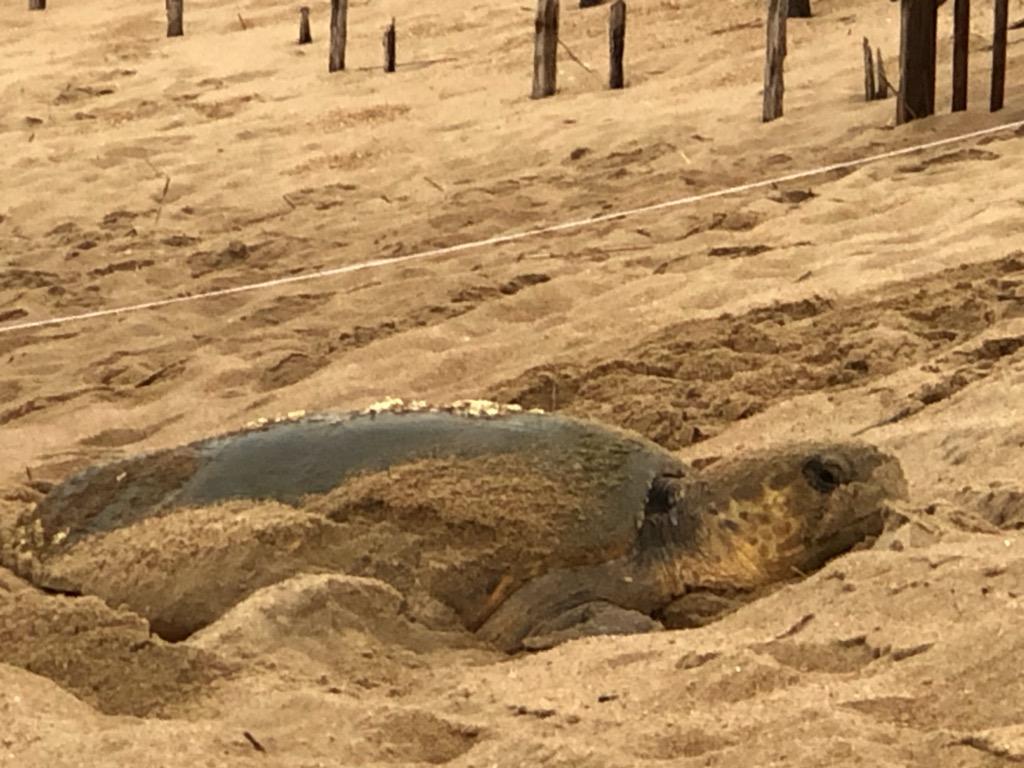Nest Science Overview
N.E.S.T. has a long history of collecting scientific data for use in sea turtle research. Our goal is to better understand sea turtle behavior and their environment so we can all work together to protect these endangered reptiles. N.E.S.T. volunteers assess sea turtle nest location, collect valuable data and measurements, and evaluate the hatching success of each nest laid on our beaches. We also collect necropsy data (autopsy of an animal) and samples to learn a turtle’s cause of death and assess if more can be done to protect them and their habitat. In 2010, we began participation in a collaborative multi-state DNA study collecting DNA samples from each nest laid along the Outer Banks.

Volunteers collecting data at nest site
In 2017, we began listening at nest sites with specialized microphones for vocalizations and sounds produced by hatchlings as they emerge from their shells and work together to dig out of the sand. In 2017 N.E.S.T. also added dataloggers in and around sea turtle nests to better understand how temperature impacts incubation and embryo/hatchling viability. The datalogger collects and stores temperature data hourly so we can determine average nest temperature throughout the entire incubation period..

Loggerhead laying eggs
The Outer Banks is considered the northern most area of where sea turtles lay their nests on the east coast. Much of the data collected by N.E.S.T. helps to distinguish nesting patterns of those turtles that choose to lay nests in our area. For instance, a sea turtle who nests in the northern Outer Banks tends to produce fewer nests in a season and the time between when they lay each nest is longer than sea turtles that nest in more southern and hotter climates. Also, sea turtle’s gender is determined by average temperature of the developing egg during the second trimester, and our generally colder nest temperatures may be responsible for producing more male sea turtles. One of the most exciting N.E.S.T. projects is using our research tools to predict when a nest may hatch. Data collected by N.E.S.T. volunteers has been included in numerous studies, scientific papers and graduate theses. [1]
N.E.S.T. continues to expand research efforts through various pilot projects. Monitoring nest over-wash and severe weather to determine its effect on egg development, adding infrared cameras to nest sites to record nest hatchings and excavations, and using microphones at nests during various hours throughout the day to determine hatchling activity patterns. Our goal is to better understand these magnificent creatures and continue to provide them with optimal nesting grounds and protection so they can thrive and hopefully one day come off the endangered species list.
**** N.E.S.T.’s work is done under and is in compliance with Endangered Species Act Permit 22ST10 and complies with all NCWRC permit requirements
[1] A few of the papers and theses that incorporate nesting and/or necropsy data collected by our volunteers include:
Avens, Larisa. Taylor, J. Christopher. Goshe, Lisa R. Jones, T. Todd. Hastings, Mervin. Use of skeletochronological analysis to estimate the age of leatherback sea turtles Dermochelys coriacea in the western North Atlantic. Endangered Species Research. Vol. 8: 165–177, 2009.
Chan, Valerie Ann. Spatial and Temporal Trends in Sea Turtle Stranding in North Carolina, 1980-2003. Masters Thesis. Nicholas School of the Environment, Duke University. Durham, NC. 2004.
Cluse WM. Boat activity and sea turtle mortality: exploring the severity of the problem in North Carolina waters. Master’s Thesis. Nicholas School of the Environment, Duke University, Durham, NC. 2002.
Cobb, Mara. Use of Caretta Caretta Nest Temperatures to Predict Hatchling Emergence. Senior Thesis. University of North Carolina Wilmington. 2020.
Goshe, LR. Avens, L. Scarf, F.S. Southwood, A.L. Estimation of age at maturation and growth of Atlantic green turtles (Chelonia mydas) using skeletochronology. Marine Biology. 57:1725–1740. 2010.
Hart, K.M. Mooreside, P. Crowder, C.B. Interpreting the spatio-temporal patterns of sea turtle strandings: Going with the flow. Biologicval Conservation Vol. 129. 283-290. 2006.
Mooreside, P.D. Integration of Physical Oceanography with Spatio-Temporal Patterns of Stranded Sea Turtles in North Carolina. Master’s Thesis. Nicholas School of the Environment, Duke University, Durham, NC. 2000.
Mrosovsky, N. Ryan, G.D. James, M.C. Leatherback turtles: The menace of plastic. Marine Pollution Bulletin. Vol. 58. 287-289. 2009.
Rush, M.D. An evaluation of nest relocation as a Loggerhead Sea Turtle (Caretta caretta) Management Technicque in North Carolina. Master’s Thesis. Nicholas School of the Environment, Duke University, Durham, NC. 2003.
Shamblin, B.M. Dodd, M.G. Bagely, D.A. et al. Genetic structure of the southeastern United States loggerhead turtle nesting aggregation: evidence of additional structure within the peninsular Florida recovery unit. Marine Biology, 158:571-587. 2001.
Snover, M.L. Hohn, A.A. Validation and interpretation of annual skeletal marks in loggerhead (Caretta caretta)and Kemp’s ridley (Lepidochelys kempii) sea turtles. Fish Bulletin. 102:682-692. 2004.
